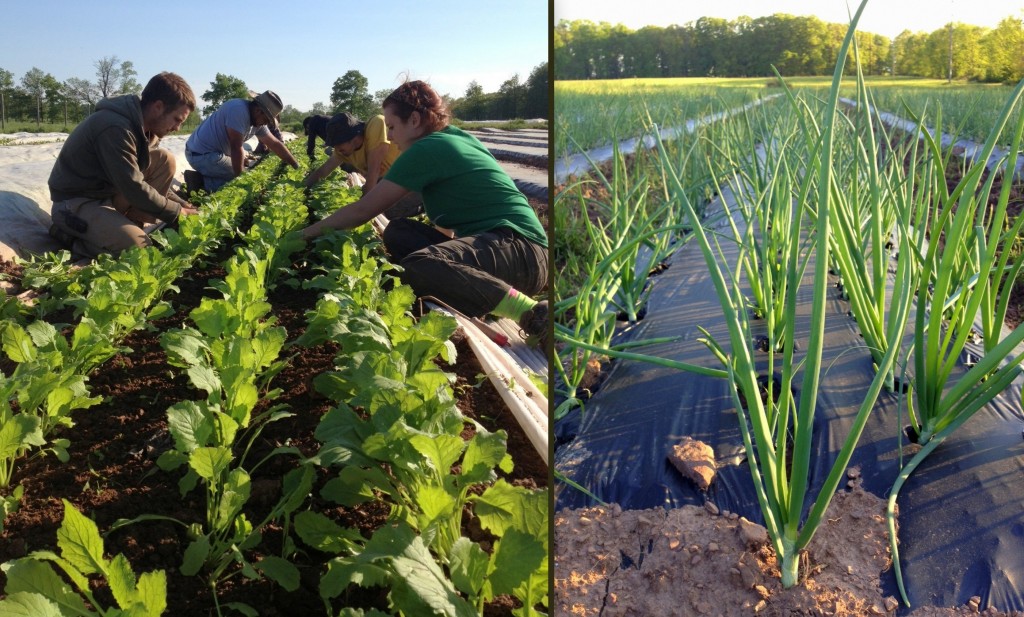Blooming Glen farm apprentice Carly Freedman has an equal love for crafting and root vegetables, for her faith and for her family. She brings to our farm crew a big heart and infectious enthusiasm. Below she shares her journey to farming.
I was born and raised in Ambler, PA surrounded by loud and loving family and friends. As the youngest of three, my parents, Michael and Audrey, were always on the run and keeping us busy with many different activities. From dance, to soccer, to softball, to swimming, to singing, to theatre, my childhood was filled with different experiences which shaped my personality and morals. In college and beyond, my passions shifted greatly from biology, to the environment, to cooking, to Judaism, to environmental education, to dairy goats, to vegetable farming.

Carly at Kayam Farm in 2008.
My passion for farming started at Ursinus College, when I heard a talk about Judaism and the environment, which led me to participate in a 2 week experiential program at Kayam, a Jewish educational farm. There, I was introduced to what it feels like to grow food, connect with the earth, community, and my religious traditions. This ignited a spark within me and I started to delve more into environmental studies, gardening, environmental education with children, and their relationship with Judaism. After much studying and learning in school and on my own, I graduated college in December 2010 with a dual degree in Biology and Environmental Studies and the mission to live the values I had developed and learn the skills that I lacked.
I began my next chapter in Spain, Morocco, and Israel, where I learned about herbal medicine, different cultures, gardening, and living in a Jewish society. From there, I went to Oregon, where I lived on a small sustainable homestead and learned animal husbandry, raising dairy goats, processing wool from sheep to sweater, preserving food, and much more.
Then I moved to southern California where I worked as a nature and farm educator at a Jewish nature reserve and conference center. I learned survival skills, Native American crafts, gardening in a chaparral climate, and how to aide in connecting children with nature.

Carly with new mama and baby goat at the Pearlstone Center.
From California, I moved to Maryland where I worked at the farm at the Pearlstone Center as a farm and educator apprentice. I cared for dairy goats and chickens, grew vegetables on 4 acres, and helped to run a 40 share CSA with a small and passionate farming community. We also served the Baltimore Jewish community with farm and nature education. That experience left me inspired to really focus on vegetable production on a larger scale.
This led me to Blooming Glen! Here, I have been able to work with an amazing crew and have begun to learn successful, sustainable, and effective systems to growing beautiful vegetables. I believe that as spiritual, physical, social, and emotional beings, when we engage all of those sides of ourselves, we connect to a whole and meaningful experience. Farming is able to engage a person on all levels; the physical labor, the social implications of participating in the sustainable agriculture movement and engaging in the farm and larger community, the emotional experience of growing food and feeding a community, and the spiritual connection developed as you connect with life! Farming is always exciting and presents new challenges and rewards. I love to harvest root vegetables (like beets and radishes) because it is always surprising and exciting to see what you will pull out of the ground. Every day is exciting as I learn new skills, recall old ones, and challenge myself at Blooming Glen.

Learning new tractor skills at Blooming Glen Farm.
When I am not farming, I love to cook, read, craft, hike, spend time with my family, play games with my grandma, and go on adventures with my friends.
I look forward to all that this season will bring- from the cold and hard days of preparing the farm in the spring, to the hard work that follows during the summer harvest and fall plantings, to the fall harvest and prep for winter in the fall. I hope to continue learning more and more each day and I look forward to meeting everyone in the greater Blooming Glen Farm community. Until then, remember to breathe properly, stay curious, and eat your beets!
Photos and text by Carly Freedman.
































